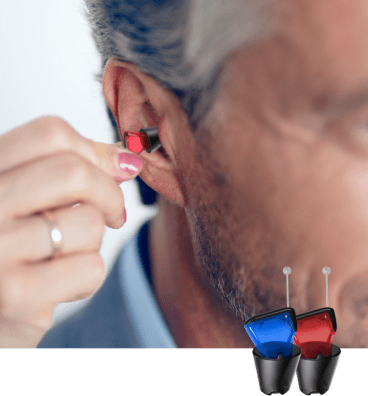Bose vs hear.com hearing aids: A Review
Bose vs hear.com; you’re probably a bit confused on which one to buy, but it all comes down to one thing: your individual hearing needs...
Read more
Gone are the days of big and bulky hearing aids. Over the past 50 years, these devices have advanced significantly—getting smaller, smarter, and far more discreet to the benefit of the one in six Americans experiencing hearing loss.
For those with mild to moderate hearing loss, invisible hearing aids are an increasingly popular option, allowing wearers to hear more of the world around them with a powerful device hidden almost entirely inside the ear canal. Here, we’ll break down exactly what invisible hearing aids are, how they work, who they’re for, and how to weigh the pros and cons.
Invisible hearing aids are the smallest, most discreet devices available to treat hearing loss, typically used to treat mild to moderate cases. Over the past decade, engineers have managed to pack high-performance processors into smaller and smaller devices, which can now be customized to fit comfortably inside the ear canal, virtually invisible to others.
They’re also sometimes referred to as invisible-in-canal (IIC) hearing aids, hidden hearing aids, or extended wear hearing aids—a modern alternative to behind-the-ear (BTE) and the slightly smaller in-the-canal (ITC) hearing aids.
Because they go by so many names, it can be useful to understand the difference between the many types and styles of hearing aids on the market these days:
These devices come in two primary styles: open-fit—also known as receiver-in-the-ear (RITE) or receiver-in-canal (RIC)—where a tiny speaker sits invisibly inside the ear, attached to the hearing aid by a clear wire, or behind-the-ear with an earmold that fits inside the ear and is connected by a sound tube. BTE hearing aids are suitable for any kind of hearing loss, from mild to profound.
Hearing aids are also sometimes referred to as Bluetooth or rechargeable, without specifying the type, so it’s important to check which of the styles listed above they’re referring to before making a final decision.
Invisible hearing aids are custom-made to fit the size and shape of the wearer’s ear canal, and programmed to meet their unique hearing loss needs. They work by capturing and analyzing surrounding sounds, and then amplifying what’s relevant based on the programming.
First, a microphone collects sounds from the environment. Then a small-but-mighty computer processor adapts in real-time to your surroundings and adjusts the sound based on the programmed hearing loss pattern. The amplifier then raises the volume on certain frequencies, reduces background noise, and improves clarity.
These new and improved signals are delivered to the ear via speaker, or receiver, filling in any gaps in listening the wearer might otherwise experience with a device that’s virtually invisible to others.
There are plenty of factors that go into choosing the right hearing aid, from the level of hearing loss to the shape of your ear canal, budget, and beyond. But here are a few of the pros and cons to think about if you’re considering an invisible hearing aid or IIC:
As with any medical decision, you’ll want to consult your doctor—more specifically, your audiologist—for advice on the style and features that make most sense for your particular situation and hearing loss pattern. But if you do decide to try an invisible hearing aid, we highly recommend hear.com’s impossibly small Horizon Mini IX, which features the most advanced hearing aid technology platform to date. Here are some of the benefits:

Some other highly rated invisible hearing aids? Signia’s Insio IIC Nx, Starkey SoundLens Synergy IQ, and the Phonak Lyric.
Interested in trying one or more of these invisible hearing aids for yourself? If you or a loved one is experiencing hearing loss and want some general guidance about hearing aids, getting started with a hearing test, or trying out a pair on a no risk basis, the experts at hear.com can help.
They’re friendly, knowledgeable, and ready to answer your questions and connect you with some of the best audiologists in the country. And once you’ve got a prescription for a medical-grade hearing aid, you can test out some of the best invisible hearing aids on the market until you find what works for you, with a 45-day trial and a money-back guarantee.
To get started, call us at (786) 526-0602 or tap the button and we’ll get in touch with you.
Learn everything you need to know about hearing aids and hearing loss.
Related Articles
Bose vs hear.com; you’re probably a bit confused on which one to buy, but it all comes down to one thing: your individual hearing needs...
Read more
What's the difference between hearing aids and amplifiers? Can a hearing amplifier improve your hearing? Get unbiased answers to these questions and more...
Read more
Both hearing aids and cochlear implants help patients with hearing loss to communicate better and engage with their world...
Read more

Take our free 2-minute question-based hearing test!
It will help you make an informed decision on treating your hearing loss.